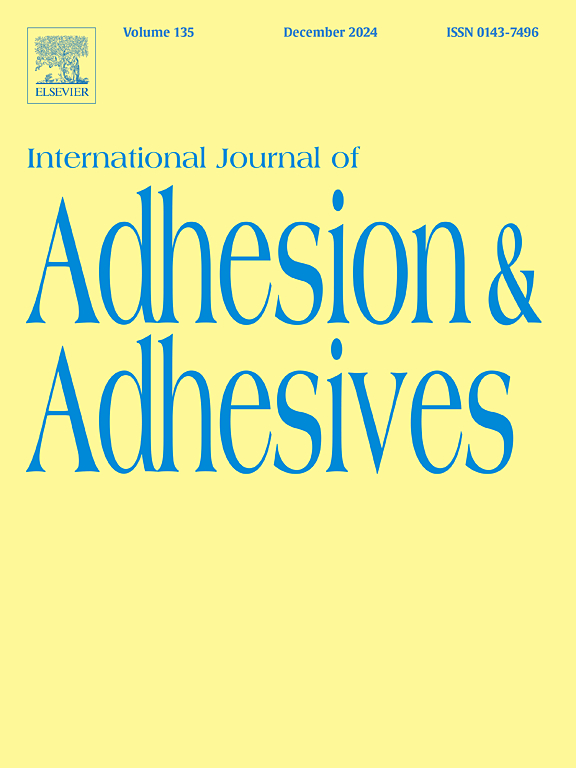粉末冶金制备的新型钨合金(W-Mn-Cu-Sn)颗粒对单搭接GFRP接头力学性能和失效特性的影响
IF 3.5
3区 材料科学
Q2 ENGINEERING, CHEMICAL
International Journal of Adhesion and Adhesives
Pub Date : 2025-05-09
DOI:10.1016/j.ijadhadh.2025.104043
引用次数: 0
摘要
研究了新型钨锰铜锡(W-Mn-Cu-Sn)合金纳米颗粒对玻璃纤维增强聚合物(GFRP)基板单搭接接头(slj)抗剪强度的影响。采用机械合金化法制备了W-Mn-Cu-Sn合金颗粒。MA是一种涉及粉末颗粒的冷焊,断裂和再焊接的重复循环的过程,生产出具有改进性能的精细,均匀的材料。该技术对均匀分散钨基体内的颗粒,从而提高合金的力学性能起着至关重要的作用。利用ImageJ软件对33次测量结果进行统计分析,确定每个样品的平均直径,平均直径为245 nm。粒径分布在121 ~ 439 nm之间。采用CuKα辐射(λ = 0.15406 nm)的X射线衍射(X'Pert PRO, Malvern PANalytical)分析了粉末的晶体学特征。在所有样品中,最突出的衍射峰对应于W相,纳米颗粒通过探针超声和高速机械混合的组合在Araldite 2014中分散。对重量比分别为1.0%、3.0%、5.0%和7.0%的钨合金(WAs)制备的slj进行了单圈剪切试验。结果表明:W-Mn-Cu-Sn纳米颗粒的加入提高了胶粘剂的力学性能,表现为剪切强度和韧性的提高;加入5.0 wt% W-Mn-Cu-Sn纳米颗粒的试样抗剪强度最大,比纯胶粘剂提高了21.7%。随着纳米颗粒含量的增加,接缝的破坏模式由混合破坏转变为内聚破坏,表明胶粘剂与GFRP基板之间的附着力和载荷传递得到改善。SEM图像表明,钨合金(WAs)改性试样断口表面呈现延性破坏模式。由于塑性空洞的形成和裂纹偏离的机理,改性胶粘剂的断裂韧性和抗剪强度得到了提高。这些发现突出了W-Mn-Cu-Sn纳米颗粒作为有效增强剂的潜力,可以增强聚合物中粘合接头(ABJs)的性能。本文章由计算机程序翻译,如有差异,请以英文原文为准。
Effects of a novel tungsten alloy (W-Mn-Cu-Sn) particles, produced through powder metallurgy, on the mechanical and failure characterization of adhesively single-lap bonded GFRP joints
The impact of novel tungsten-manganese-copper-tin (W-Mn-Cu-Sn) alloy nanoparticles on the shear strength of adhesively bonded single lap joints (SLJs) using glass fiber reinforced polymer (GFRP) substrates was examined in this study. The W-Mn-Cu-Sn alloy particles were produced via mechanical alloying (MA). MA is a process that involves repeated cycles of cold welding, fracturing, and re-welding of powder particles, producing fine, homogeneous materials with improved properties. This technique plays a vital role in uniformly dispersing particles within the tungsten matrix, thereby enhancing the alloy's mechanical properties. The mean diameters of each sample were determined from statistical analysis of 33 measurements using ImageJ software, resulting in an average diameter of 245 nm. Furthermore, the particle size distribution predominantly ranged from 121 to 439 nm. The crystallographic characteristics of the powders were analyzed using X-ray diffraction (X'Pert PRO, Malvern PANalytical) with CuKα radiation (λ = 0.15406 nm). In all samples, the most prominent diffraction peak corresponds to the W phase and the nanoparticles were dispersed in Araldite 2014 using a combination of probe sonication and high-speed mechanical mixing. Single-lap shear tests were applied to SLJs prepared with 1.0 %, 3.0 %, 5.0 %, and 7.0 % tungsten alloy (WAs) additive ratios by weight. The results show that incorporating W-Mn-Cu-Sn nanoparticles enhances the adhesive's mechanical properties, as evidenced by increased shear strength and toughness. The maximum shear strength was observed in specimens with 5.0 wt% W-Mn-Cu-Sn nanoparticles, which exhibited a 21.7 % improvement compared to the neat adhesive. The failure modes of the joints changed from mixed-mode failure to cohesive failure with increasing nanoparticle content, indicating improved adhesion and load transfer between the adhesive and the GFRP substrates. The SEM images indicate that the fracture surfaces of tungsten alloy (WAs) modified specimens exhibited ductile failure modes. Due to the formation of plastic voids and mechanisms for crack deviation, the fracture toughness and shear strength of the modified adhesive have improved. These findings highlight the potential of W-Mn-Cu-Sn nanoparticles as effective reinforcements to enhance the performance of adhesively bonded joints (ABJs) in polymer applications.
求助全文
通过发布文献求助,成功后即可免费获取论文全文。
去求助
来源期刊

International Journal of Adhesion and Adhesives
工程技术-材料科学:综合
CiteScore
6.90
自引率
8.80%
发文量
200
审稿时长
8.3 months
期刊介绍:
The International Journal of Adhesion and Adhesives draws together the many aspects of the science and technology of adhesive materials, from fundamental research and development work to industrial applications. Subject areas covered include: interfacial interactions, surface chemistry, methods of testing, accumulation of test data on physical and mechanical properties, environmental effects, new adhesive materials, sealants, design of bonded joints, and manufacturing technology.
 求助内容:
求助内容: 应助结果提醒方式:
应助结果提醒方式:


